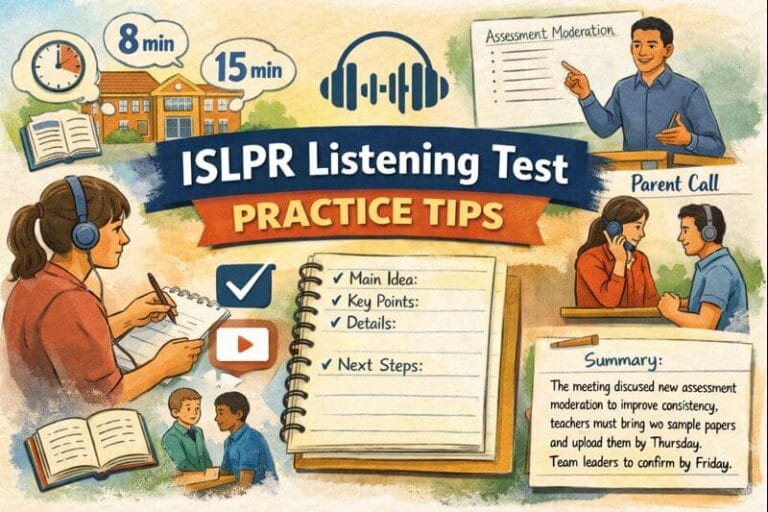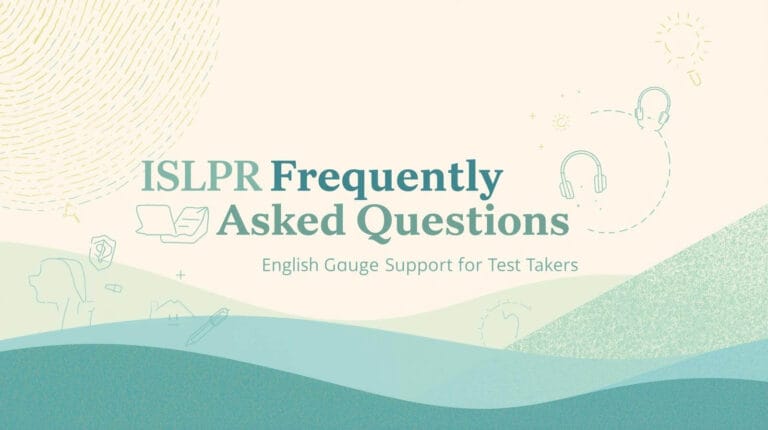Succeeding in the ISLPR Listening Test, especially for teacher registration, requires more than a solid grasp of grammar and vocabulary. You must hone your ear for the rich tapestry of Australian accents for ISLPR, from the polished, deliberate tones of a Melbourne university lecturer to the rapid-fire slang of kids at the local footy oval.
Whether you’re tackling an academic seminar, decoding staffroom banter, interpreting street-level chatter, or tuning into a regional broadcast, each context brings unique pronunciation quirks, rhythm, intonation and vocabulary.
In this guide, we unpack these accent varieties, outline five targeted strategies for ISLPR Australian accent practice, and share actionable tips to sharpen your Australian accent listening skills for ISLPR success.
1. A Snapshot of Australian Accent Contexts
1.1 Academic Lectures and Seminars
In university theatres and professional webinars, speakers use what’s often called Standard Australian English. This variety is characteristically non-rhotic, so teacher becomes “teach-uh” with clear consonants and a measured pace. You’ll hear multisyllabic terms like pedagogy, differentiation and formative assessment, pronounced precisely.
A Sydney academic might say dance with a short /æ/, while a Melbourne lecturer leans into a broader /æː/. Familiarising yourself with these distinctions lays the foundation for understanding Australian accents ISLPR exam prompts that feature high-register technical language.
1.2 Professional Workplace Conversations
In staffrooms and faculty meetings, the tone relaxes slightly. Colloquialisms such as no worries or fair go mingle with talk of curriculum design and student engagement. Pay attention to the characteristic Australian question intonation, many statements end with a gentle upward lift, so what sounds like a question may actually be a confident assertion.
Mastering this nuance is crucial for ISLPR accent practice, as misidentifying a statement for a question can affect your comprehension scores.
1.3 Informal and Street-Level Speech
On the playground or at the corner store, Aussie slang flourishes: barbie (barbecue), servo (service station), arvo (afternoon). Teenagers and young adults often clip vowels and elide consonants, pronouncing mate almost like [maɪt] and reducing something to somethin’. Speed and reduction can leave you grasping fragments unless your ear is well-trained.
Regular exposure to podcasts like Triple J or Nova’s youth segments supports Australian accent listening skills for ISLPR, helping you decode rapid colloquialisms on the fly.
1.4 Children’s Speech Patterns
Very young speakers often over-enunciate consonants and break long words into distinct syllables, elephant becomes e-le-fant. Their sing-song intonation and clear rhythm make it easier to anticipate emphasis, which is useful for school-based listening tasks that simulate classroom instructions.
Practising with story-time recordings from State Library sessions enriches your understanding Australian accents ISLPR, as you learn to switch from formal to child-friendly registers seamlessly.
1.5 Regional and Rural Varieties
In country towns, from the Wheatbelt of Western Australia to coastal Queensland, speech can be slightly slower, and diphthongs remain pure. A rural broadcaster may say “no” as a crisp [noʊ] rather than the flatter [nəʊ] typical of cities.
Community radio and local news bulletins are invaluable resources for ISLPR Australian accent practice, offering authentic examples of slower tempo and regional vocabulary.
2. Five Strategies to Develop Your Aussie Ear
To conquer Australian accents for ISLPR, you need structured, context-rich exercises. Here are five strategies to integrate into your study routine:
2.1 Build a Context-Rich Listening Library
Curate diverse audio materials representing every context above. Include ABC Education podcasts for academic lectures, Teaching Australia webinars for professional discourse, community radio streams for rural accents, Nova/National Youth Network segments for street language, and children’s story-time recordings for young speakers.
Schedule weekly rotations; Mondays for academia, Tuesdays for workplace conversations, and so on, so your ear becomes supple and adaptable across registers. This balanced library ensures that during actual ISLPR listening accents sections, you won’t be thrown by an unfamiliar setting.
2.2 Contextualised Shadowing
Move beyond generic shadowing by imitating clips from each context in real time. Select 30–60-second segments and speak along with the recording, matching pace, stress and intonation. For a university lecture excerpt, focus on pronouncing technical terms clearly; for playground chatter, mimic clipped vowels and dropped consonants.
By aligning your mouth movements with authentic speech, you reinforce auditory patterns through vocal reproduction. Repeated shadowing of workplace dialogues, children’s stories and rural broadcasts cements the muscle memory needed for Australian accent listening skills for ISLPR.
2.3 Phonemic Mapping of Signature Vowel Shifts
Australian English exhibits hallmark vowel shifts, the fronted “goose” [ʉː], raised “kit” [ɪ], broad “dance” [æː], and diphthongal “mate” [aɪ]. Create a simple chart comparing these with Standard British or American pronunciations.
Practise minimal pairs like food vs. foot, kit vs. cat, mate vs. might until those differences leap out at you. Incorporate these drills daily to sharpen your phonemic awareness, a cornerstone of ISLPR Australian accent practice.
2.4 Annotate Transcripts by Speaker Type
Whenever you work with a transcript, whether for an academic lecture or a teenage podcast; label each speaker’s context (e.g., “Academic Lecturer,” “Staffroom Colleague,” “Teenager at Park,” “Child in Classroom,” “Regional Radio Host”).
Highlight key accent features beside the text: “non-rhotic /r/,” “flapped /t/,” “fronted vowel,” “slang term.” This contextual annotation cements associations between content and accent traits, so that when you listen without text, you instantly recall both meaning and pronunciation cues.
2.5 Simulate Test Conditions with Accent Rotations
Design mock ISLPR Listening sections that rotate through at least four Australian contexts. For example: a five-minute academic lecture, a two-minute staffroom chat, a three-minute street interview, and a one-minute children’s story.
Listen once, then summarise key points and note accent observations under timed conditions. Answer comprehension questions exactly as the real test demands. Gradually reduce reliance on notes until you can extract meaning and accent features in a single uninterrupted listen an essential skill for the ISLPR Listening Test.
3. Applying These Skills to ISLPR Success
By weaving these five strategies into your daily routine, you’ll transform Australian accents from obstacles into familiar variations.
A context-rich listening library guarantees balanced exposure; contextualised shadowing forges strong auditory-motor links; phonemic mapping hones your ear for signature vowel shifts; annotated transcripts reinforce content-pronunciation pairings; and accent rotations under test conditions build resilience and speed.
When examiners score your ISLPR Listening Test, they evaluate both comprehension and your implicit grasp of phonological subtleties. Employing these strategies ensures you not only catch every detail, whether a rural host’s pure diphthong or a teenager’s clipped slang, but also respond confidently.
On test day, you’ll recognise the non-rhotic “car” pronounced as “cah,” decode rapid arvo chatter, follow complex pedagogical lectures, and understand children’s instructions effortlessly.
Conclusion
Success in the ISLPR Listening Test hinges on mastering Australian accents for ISLPR and developing robust Australian accent listening skills for ISLPR.
Through focused ISLPR Australian accent practice, building a context-rich library, shadowing authentically, mapping phonemes, annotating transcripts, and simulating test conditions, you’ll cultivate the flexible ear needed to navigate any Australian English variety.
Embrace these five targeted strategies, and you’ll stride into your ISLPR exam with the confidence and agility of a seasoned accent master. Good on ya!







